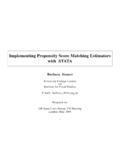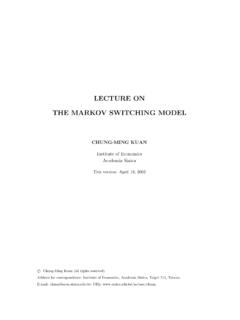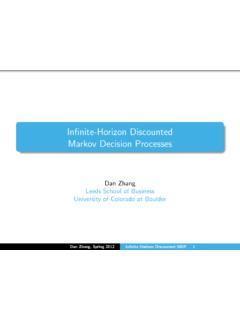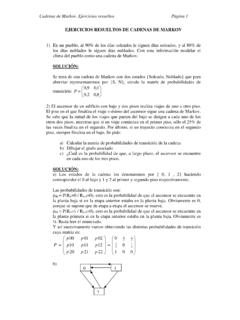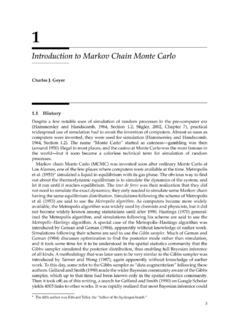Transcription of Econometric Modelling of Markov-Switching Vector ...
1 Econometric Modelling of Markov-Switching Vector Autoregressions using MSVAR for Ox . B Y H ANS -M ARTIN K ROLZIG. Institute of Economics and Statistics and Nuffield College, Oxford. December 15, 1998. Contents 1 Introduction .. 1. 2 Disclaimer .. 2. 3 Ox version .. 2. 4 Installation .. 2. 5 Main files .. 2. 6 Data organization .. 2. 7 Markov-Switching Vector autoregressions .. 3. Types of regime- switching models .. 3. Markov-Switching Vector autoregressive processes .. 4. 8 Model formulation .. 9. 9 Examples .. 9. Hamilton's model of the US business cycle .. 9. An MS-VAR model of international business cycles .. 12. A Markov-Switching Vector equilibrium correction model .. 14. 10 Notes and remarks .. 19. References .. 19. A Glossary of MSVAR functions .. 21. 1 Introduction MSVAR ( Markov-Switching Vector Autoregressions) is a package designed for the Econometric Modelling of uni- variate and multiple time series subject to shifts in regime.
2 It provides the statistical tools for the maximum likeli- hood estimation (EM algorithm) and model evaluation of Markov-Switching Vector Autoregressions as discussed in Krolzig (1997b). A variety of model specifications regarding the number of regimes, regime-dependence versus invariance of parameters etc. provides the necessary flexibility for empirical research and will be of use to econo- metricians intending to construct and use models of dynamic, non-linear, non-stationary or cointegrated systems. MSVAR is a class written in Ox (see Doornik, 1998), and is used by writing small Ox programs which create and use an object of the MSVAR class. Some knowledge of Ox will be required to use MSVAR. Ox is an object-oriented matrix language with a comprehensive mathematical and statistical function library. Matrices can be used directly in expressions, for example to multiply two matrices, or to invert a matrix. Use of the object oriented features is optional, but facilitates code re-use.
3 The syntax of Ox is similar to the C, C++ and Java I benefited greatly from comments of Mike Clements, Jurgen Doornik, Juan Toro and Carolina Sierimo . 1. MSVAR PACKAGE 2. languages. This similarity is most clear in syntax items such as loops, functions, arrays and classes. The MSVAR. class derives from the Database class to allow the easy use and exchange with other classes such as PcFiml. An additional simulation class (in development) allows Monte Carlo experimentation of the facilities in the estimation class. 2 Disclaimer This package is functional enough to be useful, but by no means finished yet (see the short to do list at the end of this paper). This package is provided as is, and you may use it at your own risk. Please report any problems or suggestions for improvement to the author (email: This package must be cited whenever it is used. 3 Ox version MSVAR requires Ox version or later. To run the program in under Windows 95/NT: oxl kroto You can also use OxRun to run the program in under Windows In that case the output will appear in GiveWin, instead of on the MS-DOS console.)
4 MSVAR is written as 100% pure Ox code, and will also work on Unix platforms. 4 Installation Create a msvar subdirectory in the oxnpackages directory and put in that directory and unzip into that directory. This allows for running files from that directory. MSVAR uses the #import statement (introduced with Ox ) to allow convenient running of the package from any directory. Add #import<packages/msvar/msvar>. at the top of your files to achieve this. You also might want to add the msvar subdirectory to your OXPATH. statement. 5 Main files the header file for the MSVAR class;. the compiled source code. the header file for some general functions used by the MSVAR class;. the compiled source code. this document. The remaining files are sample programs and data. 6 Data organization The following data files can be read directly into an MSVAR object: GiveWin (.in7/.bn7), spreadsheet (Excel, Lotus), ASCII and Gauss (.dht/.)
5 Dat). This is explained in the Ox manual. 1 Available for downloading through MSVAR PACKAGE 3. 7 Markov-Switching Vector autoregressions Types of regime- switching models Reduced form Vector autoregressive (VAR) models have been become the dominant research strategy in empirical macroeconomics since Sims (1980) and implemented in programs as PcFiml (see Doornik and Hendry (1997)). The MSVAR class provides tools to estimate VAR models with changes in regime. When the system is subject to regime shifts, the parameters of the VAR process become time-varying. But the process might be time-invariant conditional on an unobservable regime variable st which indicates the regime 1. prevailing at time t. Let M denote the number of feasible regimes, so that st 2 f ; : : :; M g. Then the conditional probability density of the observed time series Vector yt is given by 8. >. < f (yt jYt,1 ; 1 ) if st =1. p(yt jYt,1 ; st ) = >.
6 (1). : f (yt jYt,1 ; M ) if st = M;. where m is the VAR parameter Vector in regime m =1. ; : : : ; M and Yt,1 are the observations fyt,j g1. j =1 . Thus, for a given regime st , the time series Vector yt is generated by a Vector autoregressive process of order p (VAR(p) model) such that p X. E[ytjYt,1 ; st ] = (st ) + Aj (st )yt,j ;. j =1. where ut = yt , E[ytjYt, ; st] is an innovation process with a variance-covariance matrix (st ), assumed to be 1. Gaussian: ut NID(0 ; (st )): If the VAR process is defined conditionally upon an unobservable regime as in equation (1), the description of the data generating mechanism has to be completed by assumptions regarding the regime generating process. In Markov-Switching Vector autoregressive (MS-VAR) models the subject of this study it is assumed that the regime st is generated by a discrete-state homogeneous markov chain:2. Pr(stjfst,j g1j ; fyt,j g1j ) = Pr(stjst, ; ).
7 =1 =1 1. where denotes the Vector of parameters of the regime generating process. The MS-VAR model belongs to a more general class of models that characterize a non-linear data generating process as piecewise linear by restricting the process to be linear in each regime, where the regime is conditioned is unobservable, and only a discrete number of regimes are feasible. These models differ in their assumptions concerning the stochastic process generating the regime: (i.) The mixture of normal distributions model is characterized by serially independently distributed regimes: Pr(st jfst,j g1j ; fyt,j g1j ) = Pr(st; ): =1 =1. In contrast to MS-VAR models, the transition probabilities are independent of the history of the regime. Thus the conditional probability distribution of yt is independent of st,1 , Pr(ytjYt, ; st, ) = Pr(ytjYt, );. 1 1 1. and the conditional mean E[yt jYt, ; st, ] is given by E[yt jYt, ].
8 Even so, this model can be considered as a 1 1 1. restricted MS-VAR model where the transition matrix has rank one. Moreover, if only the intercept term will be regime-dependent, MS(M )-VAR(p) processes with Gaussian errors and i:i:d: switching regimes are ob- servationally equivalent to time-invariant VAR(p) processes with non-normal errors. Hence, the Modelling with this kind of model is very limited. 2 The notation Pr( ) refers to a discrete probability measure, while p( ) denotes a probability density function.. MSVAR PACKAGE 4. (ii.) In the self-exciting threshold autoregressive SETAR(p; d; r) model, the regime-generating process is not as- sumed to be exogenous but directly linked to the lagged endogenous variable yt,d .3 For a given but unknown threshold r, the probability' of the unobservable regime st is given by =1.. Pr(st = 1jfst,j g1j ; fyt,j g1j ) = I (yt,d r) = 10. =1 =1. if yt,d if yt,d r > r.
9 While the presumptions of the SETAR and the MS-AR model seem to be quite different, the relation between both model alternatives is rather close. This is also illustrated in the appendix which gives an example show- ing that SETAR and MS-VAR models can be observationally equivalent. (iii.) In the smooth transition autoregressive (STAR) model popularized by Granger and Ter asvirta (1993), exo- genous variables are mostly employed to model the weights of the regimes, but the regime switching rule can also be dependent on the history of the observed variables, yt,d : Pr(st = 1jfst,j g1j ; fyt,j g1j ; ) = F (yt0,d , r);. =1 =1. ( ). where F yt0 ,d , r is a continuous function determining the weight of regime 1. For example, Ter asvirta and Anderson (1992) use the logistic distribution function in their analysis of the business cycle. (iv.) All the previously mentioned models are special cases of an endogenous selection Markov-Switching Vector autoregressive model.
10 In an EMS(M; d)-VAR(p) model the transition probabilities pij are functions of (). the observed time series Vector yt,d : Pr(st = mjst, = i; yt,d) = pim(yt0,d ): 1. Thus the observed variables contain additional information on the conditional probability distribution of the states: a:e: Pr(st jfst,j g1j ) 6= Pr(stjfst,j g1j ; fyt,j g1j ): =1 =1 =1. Thus the regime generating process is no longer Markovian. In contrast to the SETAR and the STAR model, EMS-VAR models include the possibility that the threshold depends on the last regime, that the threshold for staying in regime 2 is different from the threshold for switching from regime 1 to regime 2 . The Vector autoregressive model with Markov-Switching regimes is founded on at least three traditions. The first is the linear time-invariant Vector autoregressive model, which is the framework for the analysis of the relation of the variables of the system, the dynamic propagation of innovations to the system, and the effects of changes in regime.






